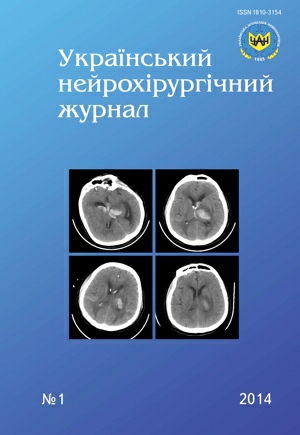Neurosurgical service in Ukraine
DOI:
https://doi.org/10.25305/unj.51527Keywords:
neurosurgical service, availability of neurosurgical beds, intensity of neurosurgical bed use, availability of neurosurgeons, operating load per one neurosurgeon, surgical activity, postoperative lethalityAbstract
Objective: To examine the state of neurosurgical service in Ukraine.
Materials and methods. The results of continuous study of hospital beds quantity, staffing and clinical work of neurosurgical units in Ukraine from 1998 to 2012 are given. Statistical data processing was carried out using time series analysis, correlation and regression analyzes.
Results. In 2012 in Ukraine availability of neurosurgical beds was 0.86 per 10,000 (1 bed per 11,650 population), the availability of neurosurgeons — 1.82 per 100,000 (1 neurosurgeon per 54,813 population). 102,947 patients (2,260 per 1 million population) were treated in neurosurgical units and 45,350 of them (996 per 1 million population) have been operated. Surgical activity was 44.1%, postoperative lethality — 4.4%.
Conclusion. The availability of neurosurgical beds and neurosurgeons in Ukraine is high enough. The intensity of beds use and operating load per one neurosurgeon are low. Indicators of highly specialized effective neurosurgical care providing have a strong positive trend in Ukraine. Ukrainian neurosurgery has a good reserve for intensive mastering of new areas of medical innovations.
References
1. Romodanov AP, Brotman MK. Neyrokhirurgicheskaya pomoshch v USSR [Neurosurgical care in the USSR]. Kiev: Zdorovja; 1981. Russian.
2. NHS standard contract for neurosurgery (adult) [Internet]. Available at: http://www.england.nhs.uk/wp-content/uploads/2013/06/d03-neurosurgery.pdf
3. Reulen H-J, Hide RAB, Bettag M, Bodosi M, Cunha E Sa M. A report on neurosurgical workforce in the countries of the EU and associated states. Task Force “Workforce Planning”, UEMS Section of Neurosurgery. Acta Neurochir. 2009;151(6):715-21. [PubMed] [CrossRef]
4. Atlas: Сountry resources for neurological disorders 2004 / World Health Organization 2004 [Internet]. Available at: http://www.who.int/mental_health/neurology/neurology_atlas_lr.pdf
5. Yoshimine T. Neurosurgical practice in Japan. [Internet]. J.M.A.J. 2007;50(6):467-70. Available at: http://www.med.or.jp/english/pdf/2007_06/467_470.pdf
6. Centre for Workforce Intelligence (England). Neurosurgery: CfWI medical fact sheet and summary sheet - August 2010 [Internet]. Available at: http://www.cfwi.org.uk/publications/neurosurgery-cfwi-medical-fact-sheet-and-summary-sheet-august-2010
7. Australian Medical Workforce Advisory Committee: The neurosurgery workforce in Australia. Supply and requirements, 1999-2010. AMWAC Report, 2000 [Internet] — Available at: http://www.ahwo.gov.au/documents/Publications/2000/The%20neurosurgery%20workforce%20in%20Australia.pdf
8. American Association of Neurological Surgeons: National Neurosurgical Procedural Statistics. 2006 Survey [Internet]. Available at: https://www.myaans.org/desktopmodules/directory/ProcedStat2006.pdf
Downloads
Published
How to Cite
Issue
Section
License
Copyright (c) 2014 Eugene Pedachenko, Nikolay Sapon, Andriy Huk, Anna Nikiforova

This work is licensed under a Creative Commons Attribution 4.0 International License.
Ukrainian Neurosurgical Journal abides by the CREATIVE COMMONS copyright rights and permissions for open access journals.
Authors, who are published in this Journal, agree to the following conditions:
1. The authors reserve the right to authorship of the work and pass the first publication right of this work to the Journal under the terms of Creative Commons Attribution License, which allows others to freely distribute the published research with the obligatory reference to the authors of the original work and the first publication of the work in this Journal.
2. The authors have the right to conclude separate supplement agreements that relate to non-exclusive work distribution in the form of which it has been published by the Journal (for example, to upload the work to the online storage of the Journal or publish it as part of a monograph), provided that the reference to the first publication of the work in this Journal is included.









